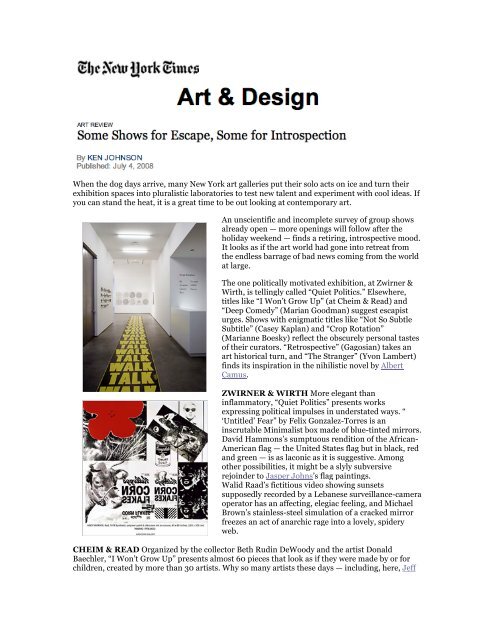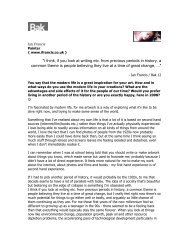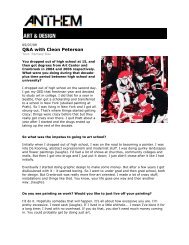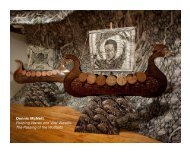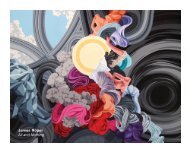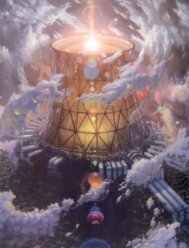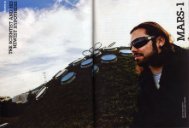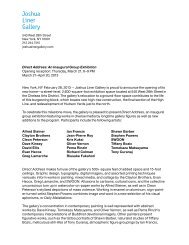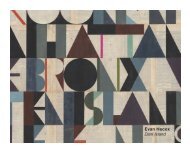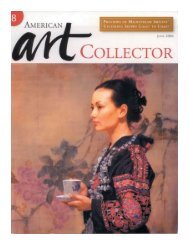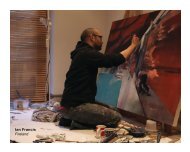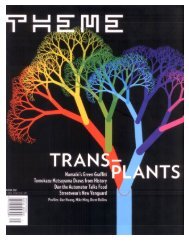Fox - New York Times (PDF) - Joshua Liner Gallery
Fox - New York Times (PDF) - Joshua Liner Gallery
Fox - New York Times (PDF) - Joshua Liner Gallery
Create successful ePaper yourself
Turn your PDF publications into a flip-book with our unique Google optimized e-Paper software.
When the dog days arrive, many <strong>New</strong> <strong>York</strong> art galleries put their solo acts on ice and turn their<br />
exhibition spaces into pluralistic laboratories to test new talent and experiment with cool ideas. If<br />
you can stand the heat, it is a great time to be out looking at contemporary art.<br />
An unscientific and incomplete survey of group shows<br />
already open — more openings will follow after the<br />
holiday weekend — finds a retiring, introspective mood.<br />
It looks as if the art world had gone into retreat from<br />
the endless barrage of bad news coming from the world<br />
at large. <br />
The one politically motivated exhibition, at Zwirner &<br />
Wirth, is tellingly called “Quiet Politics.” Elsewhere,<br />
titles like “I Won’t Grow Up” (at Cheim & Read) and<br />
“Deep Comedy” (Marian Goodman) suggest escapist<br />
urges. Shows with enigmatic titles like “Not So Subtle<br />
Subtitle” (Casey Kaplan) and “Crop Rotation”<br />
(Marianne Boesky) reflect the obscurely personal tastes<br />
of their curators. “Retrospective” (Gagosian) takes an<br />
art historical turn, and “The Stranger” (Yvon Lambert)<br />
finds its inspiration in the nihilistic novel by Albert<br />
Camus.<br />
ZWIRNER & WIRTH More elegant than<br />
inflammatory, “Quiet Politics” presents works<br />
expressing political impulses in understated ways. “<br />
‘Untitled’ Fear” by Felix Gonzalez-Torres is an<br />
inscrutable Minimalist box made of blue-tinted mirrors.<br />
David Hammons’s sumptuous rendition of the African-<br />
American flag — the United States flag but in black, red<br />
and green — is as laconic as it is suggestive. Among<br />
other possibilities, it might be a slyly subversive<br />
rejoinder to Jasper Johns’s flag paintings.<br />
Walid Raad’s fictitious video showing sunsets<br />
supposedly recorded by a Lebanese surveillance-camera<br />
operator has an affecting, elegiac feeling, and Michael<br />
Brown’s stainless-steel simulation of a cracked mirror<br />
freezes an act of anarchic rage into a lovely, spidery<br />
web.<br />
CHEIM & READ Organized by the collector Beth Rudin DeWoody and the artist Donald<br />
Baechler, “I Won’t Grow Up” presents almost 60 pieces that look as if they were made by or for<br />
children, created by more than 30 artists. Why so many artists these days — including, here, Jeff
Koons, Louise Bourgeois, Takashi Murakami, Jake and Dinos Chapman and Mike Kelley —<br />
should be so preoccupied by child-likeness remains unexplained, but it is an entertaining show.<br />
Mark <strong>Fox</strong>’s video “Nutzilla,” in which a giant Mr. Peanut violently attacks the Cincinnati Art<br />
Museum, is hilarious. George Stoll’s hand-made, child-size costumes, one a skeleton and the<br />
other a clown, are delicately evocative. And Tim Liddy’s painted simulation of an old Twister<br />
game box is an extraordinary feat of trompe l’oeil realism.<br />
MARIAN GOODMAN “Deep Comedy,” which was organized by the artist Dan Graham and the<br />
curator Sylvia Chivaratanond, does not quite live up to its title’s promise. “Sophisticated Wit”<br />
would be more accurate for this exhibition, which includes works by John Baldessari, Fischli &<br />
Weiss and Rodney Graham. But there are some instances of fairly profound humor.<br />
John Wesley’s cartoon-style painting of Donald Duck giving birth and Vija Celmins’s painting of a<br />
steaming electric frying pan are both mysteriously funny. A video by Michael Smith and <strong>Joshua</strong><br />
White about a fabricated wellness center is a dead-on spoof of <strong>New</strong> Age entrepreneurship.<br />
Christian Jankowski’s mock-documentary in which nonprofessional child actors play famous<br />
artists discussing their works satirizes art-world language and customs to surprisingly touching<br />
effect.<br />
(Comedy lovers, by the way, might consider a side trip to the Adam Baumgold <strong>Gallery</strong> where<br />
“Road Works” offers a rich selection of comic drawings, paintings and sculptures about life on the<br />
road by more than two dozen artists, including H. C. Westermann, Saul Steinberg and Joseph<br />
Yoakum.)<br />
CASEY KAPLAN Matthew Brannon’s selection of mostly small works on paper by 24 other<br />
artists has an insiderish feel. It includes Christopher Williams’s photograph of the blank white<br />
back of an art book from 1969; collages by John Stezaker in which postcards depicting rocks are<br />
pasted over film stills of lovers; small abstractions by Nick Mauss made by scratching through<br />
aluminum leaf into a black gesso ground; and two posters for a Wade Guyton exhibition in<br />
London illustrated by photographs of a muscular man’s torso.<br />
What holds it all together is an exquisite aliveness to form and materials, and an acute alertness<br />
to conventions of style and representation. It is absorbing and often puzzlingly abstruse.<br />
MARIANNE BOESKY Organized by the independent curator Clarissa Dalrymple, “Crop<br />
Rotation” is almost as perplexing as Mr. Brannon’s show, but it is more theatrically engaging.<br />
The words “walk” and “talk” printed in yellow on black on a length of plastic stuck to the floor — a<br />
piece first made in 1970 by Ferdinand Kriwet — lead to a room where a rickety wooden structure<br />
by Marc Bijl holds up three horizontal mirrors reflecting words spray-painted in reverse on the<br />
wall. They read, “The construction of life is at present in the power of facts.”<br />
In a corner of the main gallery two enormous black circles painted on each wall by Neil Campbell<br />
give the momentarily thrilling illusion of openings into infinite space. But a poetic tableau by<br />
Marlo Pascual involving old photographs under glass, a seashell, a large rock, electric lights, an<br />
antique telephone and a much enlarged page from Walker Percy’s novel “The Moviegoer” is<br />
portentously heavy-handed.<br />
Don’t miss Jeffrey Wells’s video projection of an almost invisible line wavering in one corner of<br />
the gallery or Mr. Kriwet’s video montage of television clips from the 1972 presidential race<br />
between Richard M. Nixon and George McGovern.<br />
GAGOSIAN At a certain point in their careers some artists become custodians of their own<br />
histories. Marcel Duchamp had his works reproduced in miniature and neatly installed in<br />
portable boxes. One of them is the centerpiece of “Retrospective,” which presents works that<br />
function as compendiums of their maker’s earlier efforts.<br />
Along with pieces on paper by Roy Lichtenstein and Jasper Johns, there’s “Red,” a terrific, mostly<br />
gray canvas by Andy Warhol that has images of Mao, Marilyn, a car crash, a tomato soup can, a<br />
cow and a big red flower silkscreened on it.<br />
One fascinating room presents written and photographic documentation of all the performances<br />
Chris Burden did from 1971 to 1973. Another has all the films and videos that Douglas Gordon has<br />
produced since 1992, running in the dark on 50 monitors.
YVON LAMBERT An enigmatic array of seven sculptures by seven artists, “The Stranger” might<br />
be a meditation on the absurdity of the human condition. Richard Jackson’s “Big Baby,” a large,<br />
yellow smiley face made of shiny plastic with pudgy, humanoid limbs and male genitalia attached,<br />
lies on its pedestal like a helpless infant. Berlinde de Bruyckere’s wax torso in an old vitrine looks<br />
like the remnant of a medieval sculpture of a tortured saint crossed with a slab of fatty meat.<br />
And “The Long Awaited” by Patricia Piccinini, in which a sleeping boy cradles in his lap the head<br />
of a sleeping, grandmotherly mermaid, could be a scene from a new Steven Spielberg fantasy.<br />
Meanwhile, in a nod to the show’s title, George Segal’s blue woman at a cafe table reads from a<br />
real copy of that tale of existential malaise by Camus.<br />
An Art Lover’s Summer Guide<br />
ADAM BAUMGOLD “Road Works,” through Aug. 15 at 74 East 79th Street, Manhattan, (212)<br />
861-7338, adambaumgoldgallery.com.<br />
MARIANNE BOESKY “Crop Rotation,” through Aug. 15 at 509 West 24th Street, Chelsea, (212)<br />
680-9889, marianneboeskygallery.com.<br />
CHEIM & READ “I Won’t Grow Up,” through Aug. 29 at 547 West 25th Street, Chelsea, (212)<br />
242-7727, cheimread.com.<br />
GAGOSIAN GALLERY “Retrospective,” through Aug. 22 at 522 West 21st Street, Chelsea, (212)<br />
741-1717, gagosian.com.<br />
MARIAN GOODMAN “Deep Comedy,” through July 30 at 24 West 57th Street, Manhattan,<br />
(212) 977-7160, mariangoodman.com.<br />
CASEY KAPLAN “Not So Subtle Subtitle,” through July 31 at 525 West 21st Street, Chelsea,<br />
(212) 645-7335, caseykaplangallery.com.<br />
YVON LAMBERT “The Stranger,” through July 31 at 550 West 21st Street, Chelsea, (212) 242-<br />
3611, yvon-lambert.com.<br />
ZWIRNER & WIRTH “Quiet Politics,” through Aug. 29 at 32 East 69th Street, Manhattan,<br />
(212) 517-8677, zwirnerandwirth.com.<br />
http://www.nytimes.com/2008/07/04/arts/design/04chel.html


